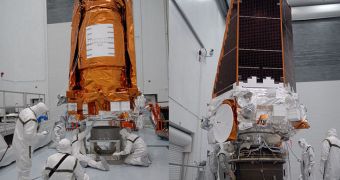Since 1995, astronomers were able to discover more than 500 planets outside of our solar system, of which a few resembled Earth in some regards, and one was heralded as a “second Earth.” Experts in the United States are currently in a process of assessing how to continue work in this field.
While the search for an Earth twin was an elusive concept at first, it quickly became reality when experts reported the discovery of Gliese 581g earlier this year.
The body orbits its parent star inside the habitable zone, has a temperature range from nearly 80 to -4 degrees Celsius, and may in fact hold liquid water on its surface. Recently, a new study even modeled its atmosphere.
Ever since the announcement was made this September, some astronomers have been keen to show that the body actually does not exist, whereas others moved on to ponder at the implications the finding has on this hot field of astronomical research as a whole.
Scientists at the Massachusetts Institute of Technology (MIT), in Cambridge, were among them. Some of the experts working here are in charge of analyzing data sent back by the NASA Kepler Telescope.
This orbital instrument was designed specifically to search for Earth-like exoplanets. At a nearly 50 percent positive identification rate, and with over 750 candidates already proposed, the observatory may add at least 350 new planets to the other 500 already known all by itself.
The MIT team says that experts and students at the Institute are not concerned by all this, and adds that research is going on as usual into finding new and advanced methods of conducting the search.
One of the major drawbacks that Kepler has is its inability to look at stars that are located near to our solar system. This is a shame, because nearby stars are the most easily trackable with ground-based observatories, scientists say.
At the Institute, astronomers and engineers are now working on developing the Transiting Exoplanet Survey Satellite (TESS), an instrument featuring six wide-angled, high-precision cameras.
The observatory could observe as much as 2.5 million stars, potentially discovering between 1,600 and 2,700 new exoplanets. About 100 and 300 of these will be small planets, and even less Earth twins.
In addition to TESS, MIT experts are also developing ExoplanetSat, a study network made up of a dozen “triple CubeSats” (three Rubik Cube-sized satellites stuck together). The leader of the effort is expert David Miller, who is based at the MIT Department of Aeronautics and Astronautics.
Until these advanced projects become reality, astronomers will have to be satisfied with waiting for the launch of the NASA James Webb Space Telescope, the replacement for Hubble, and the most complex orbital observatory ever to be constructed.
It features the most advanced suite of scientific instruments and light shields, and experts believe that, after the telescope launches in 2014, we will become able to observe Earth twins easier than ever.

 14 DAY TRIAL //
14 DAY TRIAL //